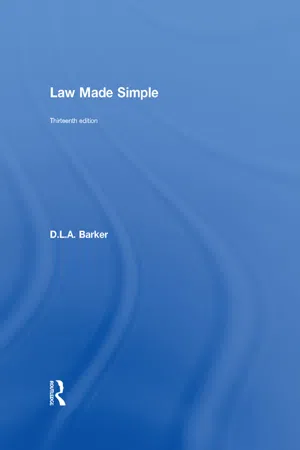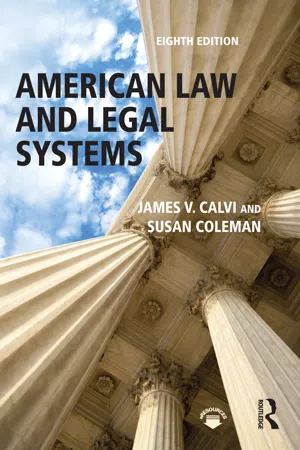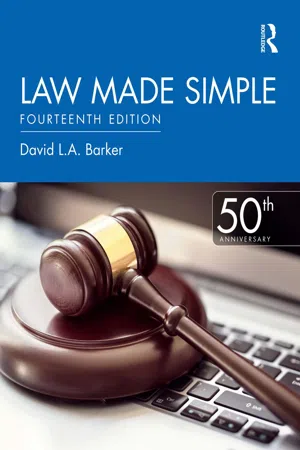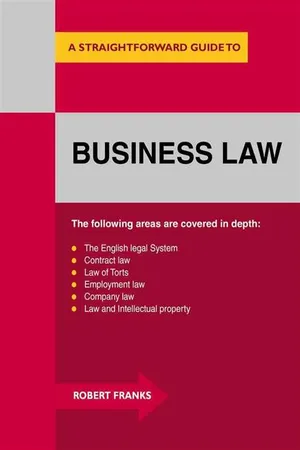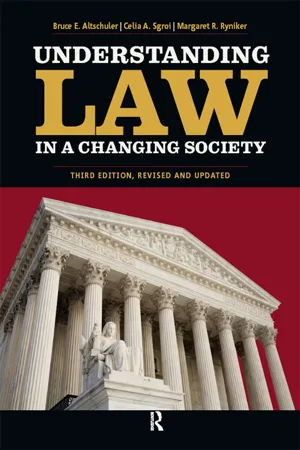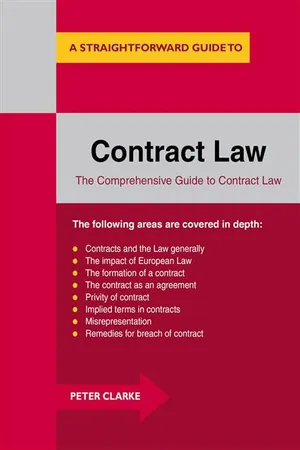Law
Types of Contract
Types of contracts include express contracts, which are explicitly agreed upon by all parties; implied contracts, which are inferred from the conduct of the parties involved; and unilateral contracts, where one party makes a promise in exchange for an act from another party. Additionally, there are bilateral contracts, which involve promises from both parties, and void or voidable contracts, which are unenforceable for various legal reasons.
Written by Perlego with AI-assistance
Related key terms
Related key terms
1 of 4
Related key terms
1 of 3
10 Key excerpts on "Types of Contract"
- eBook - ePub
- David Barker(Author)
- 2014(Publication Date)
- Routledge(Publisher)
Chapter 7The law of contract
Key points
• what constitutes a contract• the essentials of a valid contract• void, voidable and illegal contract• the ways in which a contract may be discharged• remedies for breach of contractIn his book Principles of the Law of Contracts , Sir William Anson defined a contract as a legally binding agreement made between two or more parties, by which rights are acquired by one or more to acts or forbearances on the part of the other or others . Shortly it may be defined as an agreement between two or more parties that is intended to have legally enforceable consequences.The agreement referred to in the definition means a meeting of minds, called in law consensus ad idem , signifying that the parties are agreed together about the same thing. The definition also emphasizes that the parties to the contract must intend that their agreement shall be legally enforceable. Unless the law recognizes this and enforces the agreements of parties, it would be impossible to carry on commercial or business life. For this reason the law of contract plays a leading role in courses on business studies.These contractual agreements give rise to rights and obligations that the law recognizes and enforces. But certain agreements, such as domestic and social arrangements, are not intended by the parties to be legally binding. The law allows for this. Suppose, if Cumming and Gowing agree to meet for dinner and Gowing fails to turn up, the law will do nothing in the matter. The agreement was not intended to create legal rights and duties, and, as such, it is not a contract in law. Every contract is an agreement, but not every agreement is a contract.The object of the law of contract is to identify those agreements that it will enforce and those that it will not. This is of prime importance and will be referred to later in more detail. - eBook - ePub
- James V. Calvi, Susan Coleman(Authors)
- 2016(Publication Date)
- Routledge(Publisher)
Ensuring stability and certainty is the quintessential goal of contracts. Those who enter into these agreements do so with the knowledge that failure to live up to their part of the bargain may result in a court order for specific performance or for monetary damages as well as damage to their reputation in the community. The importance of contract stability is emphasized by Article I, § 10 of the U.S. Constitution, which provides that “No State shall … pass any … Law impairing the Obligation of Contracts.” In earlier days, freedom of contract was virtually uncircumscribed by government restrictions; people contracted as they pleased, with the only real restraint being that contracts for illegal purposes were not enforceable by the courts. For example, government contracts secured by bribing a public official cannot be enforced by the corporation offering the bribe. That rule is still valid; however, other restrictions have been added. Consider, for example, employment contracts that are governed by regulations barring discrimination, requiring minimum wages, limiting hours, and providing workers’ compensation, to name only a few.As society becomes more complex and more litigious, legislatures, administrative agencies, and courts at all levels of government are placing greater restrictions on the freedom to contract. Contract law permeates our daily lives in such diverse areas as sales, credit, employment, and various other commercial transactions.CONTRACTUAL TERMS OF ART
The field of contracts is an area of law in which mysterious terms of art abound. Contracts may be characterized as express or implied; bilateral or unilateral; executory or executed; and void, voidable, and unenforceable. It will be helpful for you to have some understanding of these terms as you learn about contracts.An express contract is one in which the terms are stated by the parties; it may be either an oral or a written contract. An example would be your agreement to buy a class ring for the sum of $300 under a written contract. An implied contract is one that is inferred from the conduct of the parties. Your conduct in entering a restaurant and ordering a meal gives rise to an implied contract that you will pay the price stated on the menu for the food, even though you may not expressly say so to the waiter when you order. In each case you have entered into a contract, and the only difference is in the type of evidence necessary to establish the contract.2A bilateral contract is one in which the parties exchange promises to do some future act. You agree with the car dealer that you will pay for your new Jaguar when you take delivery next week. Each of you has promised to do something in the future: the dealer to deliver the car and you to pay for it. In contrast, a unilateral contract is one in which one party acts immediately in response to the offer . Assume that you tender a monetary reward for the return of your much-loved, but lost, dog Sebastian. Sterlin finds Sebastian and returns him to you. The response is in the form of immediate action rather than a mutual exchange of promises.3 - eBook - ePub
- David L.A. Barker(Author)
- 2020(Publication Date)
- Routledge(Publisher)
Chapter 7The law of contract
Key points
- what constitutes a contract
- the essentials of a valid contract
- void, voidable and illegal contract
- the ways in which a contract may be discharged
- remedies for breach of contract
In his book Principles of the Law of Contracts , Sir William Anson defined a contract as a legally binding agreement made between two or more parties, by which rights are acquired by one or more to acts or forbearances on the part of the other or others . Shortly it may be defined as an agreement between two or more parties that is intended to have legally enforceable consequences.The agreement referred to in the definition means a meeting of minds, called in law consensus ad idem , signifying that the parties are agreed together about the same thing. The definition also emphasizes that the parties to the contract must intend that their agreement shall be legally enforceable. Unless the law recognizes this and enforces the agreements of parties, it would be impossible to carry on commercial or business life. For this reason the law of contract plays a leading role in courses on business studies.These contractual agreements give rise to rights and obligations that the law recognizes and enforces. But certain agreements, such as domestic and social arrangements, are not intended by the parties to be legally binding. The law allows for this. Suppose, if Cumming and Gowing agree to meet for dinner and Gowing fails to turn up, the law will do nothing in the matter. The agreement was not intended to create legal rights and duties, and, as such, it is not a contract in law. Every contract is an agreement, but not every agreement is a contract.The object of the law of contract is to identify those agreements that it will enforce and those that it will not. This is of prime importance and will be referred to later in more detail.An agreement will be enforced when the following essential elements exist:7.1 Essentials of a valid contract
- Offer and acceptance
- eBook - ePub
Technology Entrepreneurship
Taking Innovation to the Marketplace
- Thomas N. Duening, Robert A. Hisrich, Michael A. Lechter(Authors)
- 2020(Publication Date)
- Academic Press(Publisher)
Businesses are free to agree, within broad legal limits, upon whatever terms they see fit. Those terms define respective rights and obligations of the parties, and/or rules under which they operate, for the duration of the contract. A contract serves, in effect, as the private law of these businesses. That means that it is extremely important to understand when a contract is created and how it can be enforced. A failure to form a valid contract when intended, or inadvertently committing a business to obligations, can be catastrophic. (Just ask the Winklevoss’.)In this chapter, we will consider the basic sources and concepts of contract law, the anatomy of a typical agreement, and introduce various types of agreements often encountered by technology entrepreneurs.Sources of Contract Law
When an issue of contract law arises, it is generally in connection with one of the following questions: Has a contract been formed? If so, what are the terms? And, if there is a breach, is there an applicable defense? If not, what are the remedies?Answering these questions, however, is complicated by the fact that a different body of contract law applies depending upon the subject matter of the transaction, the location of the parties to the transaction, and the terms of a written agreement.Two primary sources of law govern contracts between parties located within the United States. Historically, the common law of a state (precedential judicial decisions) was applied to contracts formed or performed within its boundaries.1 Consequently, the law varied from state to state. As the frequency of interstate transactions increased, a Uniform Commercial Code (UCC) was developed for, among other things, the sale of goods.2 The UCC, consisting of 10 articles, covers the rights of buyers and sellers in commercial transactions. Drafted in 1952, the UCC has been adopted in its entirety by every state except Louisiana (which has adopted about half of the code). Each state has unique adaptations of the code to fit its own common law findings. Generally, business owners can access a state’s UCC through that state’s Secretary of State Office. The UCC defines goods as all things that are movable at the time of identification to a contract for sale.3 - eBook - ePub
Business Law
A Straightforward Guide
- (Author)
- 2014(Publication Date)
- Straightforward Publishing Digital(Publisher)
Ch. 1
BUSINESS LAW-THE LAW OF CONTRACT
Underpinning all contracts are four main principles:
1) A contract is an agreement between the parties to that contract-one person makes an offer and the other accepts that offer 2) Both parties have an intention to be legally bound by the agreement-this is usually known as an intention to create legal relations3) Parties to the agreement need to be absolutely clear as to the terms of the agreement – this is the main area of contention with contracts, as we will see laterc4) There must be consideration provided by each of the parties to the contract – this means that one person promises to give or deliver and the other promises to pay. The offer and the payment – either monetary or in kind - is the consideration. When making a contract, or entering into a contract all parties to the contract must have the legal capacity to enter into a contract. Very importantly, a contract, in most cases, does not have to be in writing – a piece of paper is not necessary, the agreement and evidence of that agreement forms the basis of contract. There are a few important exceptions, including contracts relating to interests in land (Law of property (Miscellaneous Provisions) Act 1989, s 2(1)) and consumer credit (Consumer Credit Act 1974).Other factors affecting formation include: • Form-the way the contract is created (e.g. the sale of land can only be made in the form of a deed) Form is an issue with specialty contracts but not with simple contracts• Privity of contract and the rights of third parties-generally a contract is only enforceable by or against a party to it, subject to exceptions and certain third party rights are now protected in the Contracts (Rights of Third Parties) Act 1999.The nature of contracts – unilateral and bilateral contracts
The majority of contracts entered into are known as Bilateral contracts. This quite simply means that each party to a contract agrees to take on an obligation. This obligation is underpinned by a promise to give something to the other party. A Unilateral contract will arise where one party to the contract will make a promise to do something (usually to pay a sum of money) if the other party carries out a certain task. Examples of this are where you might undertake to pay someone a sum of money if they shave off their hair for charity or give up smoking. Estate agents enter into unilateral contracts whereby a percentage of sales go to the agent if they sell the property. However, the agent is not legally bound to sell the property, just to try to sell it. - eBook - ePub
- Bruce E. Altschuler, Celia A. Sgroi, Margaret R. Ryniker(Authors)
- 2016(Publication Date)
- Routledge(Publisher)
The contracting process goes through several distinct stages: formation (which may be preceded by negotiation); performance (which will be the end of the process if both parties perform as agreed); breach (when one or more parties do not perform as agreed); and remedy (which will be a judicial remedy in the event that one or more of the parties turns to the legal system for relief). We must remember that not all contracts that are breached end up being the basis of lawsuits. In a great many cases the parties work matters out for themselves and salvage the transaction as best they can. This is particularly the case when contracting parties have an interest in a long-term relationship with one another. After all, the adversarial proceedings in a lawsuit are not conducive to continued good relations between the parties.Despite the prevalence of contracts in our lives, most people know little about them. For example, most people assume that contracts must be written, although in fact only certain contracts must be written to be enforceable. There are several Types of Contracts with which you need to be familiar to get the most out of the readings and cases in this chapter. Contracts may be either express or implied. They may be bilateral or unilateral. They may be executory or executed.An express contract is one whose existence and terms are clearly manifested by the parties. Express contracts may be oral or written. Implied contracts are those whose existence and terms are not clearly manifested but that are implied by the actions of the parties. The parties to an express contract create the legal obligations involved by their agreement; conversely, the legal obligations of an implied contract are imposed externally by operation of law.A bilateral contract is a two-sided contract, because each party to the contract makes a promise to the other. It is the exchange of mutual, reciprocal promises. In the case of a unilateral contract, only one party makes a promise, which the other party can accept by performing a requested action.An executory contract is one that is not yet completed because some act or other promise has yet to be performed. An executed contract is one that is completed; there is nothing left to be done to accomplish the agreement.An underlying assumption of contract is that agreements are mutual and voluntary. In reality, however, there are several factors that may adversely affect a party’s ability to consent freely to a contract. Several of these factors, such as lack of capacity, mistake, fraud, or duress, are discussed in the following materials. Another factor that affects the reality of consent to an agreement is the relative bargaining power of the parties. If one party has a great deal more power than the other, the result may be an extremely one-sided contract that unfairly favors the more powerful party. Such exploitative contracts may be unenforceable because they are unconscionable, that is, so unfair and one-sided that no informed person would ever freely agree to them. - eBook - ePub
- Terrence M. O'Connor(Author)
- 2014(Publication Date)
- Berrett-Koehler Publishers(Publisher)
Chapter 4TYPES OF GOVERNMENT CONTRACTS
B ecause the government needs so many different things under so many different situations, it needs a wide range of legal instruments to get those things. The generic word for the piece of paper showing some sort of deal between a federal agency and somebody else is agreement.Agreements come in all sorts of shapes and sizes. Two common ones are interagency agreements, which describe how one agency will work with another agency, and blanket purchase agreements, which an agency sets up with a vendor to make it easier for the agency to buy certain items repetitively.Only some kinds of agreements are contracts. Whether a document the government has signed is a contract is important for several reasons. For example, some agreements are contracts subject to the Contract Disputes Act (CDA). If a vendor has an agreement with the government that is not subject to the CDA, like a settlement agreement that does not become a contract modification, the vendor’s rights and remedies against the government might be limited.The focus of this chapter is the procurement contract, in which a government manager may be involved. To clarify the distinction between generic agreements and binding contracts, we first discuss the various types of agreements the government enters into. We then turn to the procurement contract, focusing on the essential elements required for forming an express government contract. Finally, we discuss implied contracts—the kinds of contracts to which government managers worry about inadvertently obligating the government.Manager Alert
Only some kinds of agreements are contracts.DIFFERENT KINDS OF AGREEMENTS
The government enters into a number of agreements that are not procurement contracts. These include grants and cooperative agreements and concession contracts.Grants and Cooperative Agreements
The most common non-procurement agreement is a grant or cooperative agreement. A grant agreement describes a deal between the government and a grantee. - eBook - ePub
Contract Law
A Straightforward Guide
- (Author)
- 2014(Publication Date)
- Straightforward Publishing Digital(Publisher)
Ch. 2
Forming a Contract
Underpinning all contracts are four main principles: 1) A contract is an agreement between the parties to that contract-one person makes an offer and the other accepts that offer 2) Both parties have an intention to be legally bound by the agreement-this is usually known as an intention to create legal relations 3) Parties to the agreement need to be absolutely clear as to the terms of the agreement – this is the main area of contention with contracts, as we will see laterIn this chapter we look at the main principles underpinning forming a contract. We look at the nature of contracts and the notion of offer and acceptance plus certainty of contract and terms implied into a contract. The intention to create legal relations is examined along with different Types of Contract and capacity to enter into a contract.4) There must be consideration provided by each of the parties to the contract – this means that one person promises to give or deliver and the other promises to pay. The offer and the payment – either monetary or in kind - is the consideration. When making a contract, or entering into a contract all parties to the contract must have the legal capacity to enter into a contract. Very importantly, a contract, in most cases, does not have to be in writing – a piece of paper is not necessary, the agreement and evidence of that agreement forms the basis of contract. There are a few important exceptions, including contracts relating to interests in land (Law of property (Miscellaneous Provisions) Act 1989, s 2(1)) and consumer credit (Consumer Credit Act 1974). We will outline those contracts that do need to be in writing later on in this chapter. Other factors affecting formation include:• Form-the way the contract is created (e.g. the sale of land can only be made in the form of a deed) Form is an issue with specialty contracts but not with simple contracts - B.S. Patil, S.P. Woolhouse(Authors)
- 2019(Publication Date)
- CRC Press(Publisher)
2The Contract
2.0 IntroductionA contract is an agreement. An agreement arises out of the acceptance of a proposal or offer. Thus, an agreement is a promise or a set of reciprocal promises. It necessarily involves a minimum of two persons, although a greater number may be involved. The person who makes a proposal is called the “promisor” and the person who accepts the proposal is called “promisee”. Consequently, one person cannot enter into an agreement with himself even if discharging duties in different roles.Although all contracts are agreements, the converse is not true. All agreements are not contracts. Section 2(h) of the Indian Contract Act defines a contract as an agreement enforceable by law. An agreement not enforceable by law is said to be void; whereas an agreement which is enforceable by law at the option of one or more of the parties thereto, but not at the option of other or others, is called a voidable contract. These terms are discussed in this chapter. Other terms, including contingent contracts, collateral contracts, quasi-contracts, implied contracts, contracts of indemnity and guarantee are dealt with below. Necessity of written contracts, contract documents and types of engineering contracts are other topics considered in this chapter.
The following provisions of the Indian Contract Act are referred to and/or discussed in the paragraphs below as follows.2.1 Provisions of the Act
Section 10 of the Indian Contract Act sets out the essential features of a valid contract. It provides as follows (see below and over page):2.2 Essentials of a Valid Contract- Lisa M. Fairfax, Paul Berman(Authors)
- 2018(Publication Date)
- Research & Education Association(Publisher)
CHAPTER 4 CONTRACTS4.1 MEANINGS OF TERMSContractThe Restatement (Second) of Contracts (“Restatement”) is a set of statements reflecting generally agreed upon pronouncements of common law contract rules. Section 1 of the Restatement defines a contract as “a promise or a set of promises for the breach of which the law gives a remedy, or the performance of which the law in some way recognizes a duty.” Thus, at its core, contract law is concerned with enforcing promises between parties, but only those promises that the law recognizes as enforceable. In this respect, a contract is a transaction where one or both parties make a legally enforceable promise. Contract law provides the principles for determining whether a promise is enforceable.Express ContractAn express contract is a promise stated in words, either oral or written.GoodsAs will be discussed in Chapter 8 , Article 2 of the UCC governs all transactions for the sale of goods. The UCC defines goods as all things that are movable at the time of the contract.Implied ContractAn implied contract is a promise that is inferred from a person’s conduct or the circumstances of the transaction.PromiseA promise is an undertaking or commitment to act or refrain from acting in a specified way in the future. When an exchange is entirely instantaneous, there is no contract because neither party makes a promise to the other. Thus, if A purchases a clock from B for $100 and at the point of sale A gives B $100 and B gives A the clock, this is an instantaneous exchange. In such an exchange, each party has fully performed her obligation and no promises have been made. The exchange therefore is not a contract, but is referred to as an executed exchange
Index pages curate the most relevant extracts from our library of academic textbooks. They’ve been created using an in-house natural language model (NLM), each adding context and meaning to key research topics.
Explore more topic indexes
Explore more topic indexes
1 of 6
Explore more topic indexes
1 of 4
